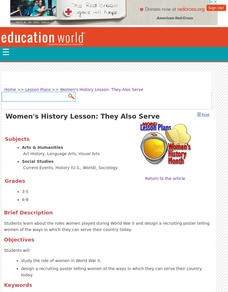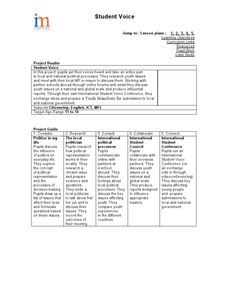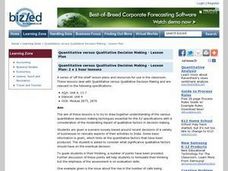University of California
The Vietnam War (1945 – 1975)
Have you ever wanted to do something so perfectly you wound up not doing it well at all? Young historians use primary and secondary documents to analyze the United States involvement in the Vietnam War. The issues surrounding the...
Curated OER
Witch Hunt or Red Menace? Anticommunism in Postwar America, 1945-1954
Students investigate the goals and methods of the House Un-American Activities Committee and offer an opinion regarding whether their investigation of Hollywood was justifiable.
Curated OER
Lights, Shoals & Soundings
Young scholars explore nautical charts and their symbols, with a bit of fun thrown in.
Japan Society
The Bubble Economy and the Lost Decade
Explore Japanese society and national identity. Class members share ideas about the Japanese economy and then investigate a series of resources, including an article, a film, a lecture, and a poem, to learn about Japan's Bubble Economy...
Curated OER
Holidays and Hotels
Students pairs discuss common activities associated with vacations and hotels. In this language arts worksheet, students complete fill-in-the-blank and matching activities, as well as engage in conversation starters.
Curated OER
Europe Project: Let’s Take a Trip
Seventh graders travel to Europe. In this research skills lesson, 7th graders plan trips to Europe that include details about the places they will visit, how much the trip will cost, and the cultural experiences they think they will...
Curated OER
Student Travel in the Shadow of War
Students research on the Web and in magazines and newspapers what a variety of school districts have decided on student travel during the War in Iraq. Students examine the rationale the administrators or state officials use for canceling...
Read In English
White Fang
White Fang gets into the mind of a wild wolfdog as people domesticate him. The story tells of trials with violent animals and humans alike. White Fang captures readers' hearts as the pup separates from his family.
University of Wisconsin
Why Did the Triangle Fire Occur?
An investigation of the 1911 New York City Triangle Shirtwaist Factory fire leads class members to examine primary and secondary source materials related to the event and apply what they learn about the working conditions at the time to...
University of North Carolina
Clichés
When it comes to writing, cliches are as old as dirt. A handout on tired phrases provides examples of cliches, as well as a description of the negative effects they have on a paper. Writers discover specific words and phrases to avoid,...
Curated OER
Charting the Weather
Students research and conduct non-experimental research, such as journals, the weather channel and the internet, to collect and record data for analysis on weather conditions in the United States and abroad. They identify, pronounce and...
Curated OER
Multiple Perspectives on the Korean War
Students interpret historical evidence presented in primary and secondary resources. In this Korean War instructional activity, students examine and analyze primary sources regarding U.S. involvement in the Korean War.
Curated OER
Military Women
Students review the history of female participation in the armed forces and throughout various conflicts. They participate in a class discussion and consider many of the controversial issues surrounding women in the military.
Curated OER
They Also Serve
Learners explore the roles women played during World War II. They design a recruiting poster telling women of the ways in which they can serve their country today and present their posters to the class.
Curated OER
Why do People Migrate?
Second graders examine the reasons for human migration. In this human migration instructional activity, 2nd graders make lists of reasons why people migrate. Students view pictures of people who have migrated and discuss why. Then the...
Curated OER
The Political Dr. Seuss
Students discuss the role political cartoons have played in U.S. politics and public affairs since the 1700's. They analyze some of the political cartoons Dr. Seuss drew during World War II and discuss how these cartoons conveyed his...
Curated OER
The People of World War Two
Students explore how those children returning felt isolated and how shocked they were by the changes in Britain. They explain the impact that World War Two had upon the generation born during the war. Students explore how people felt...
Curated OER
Student Voice
Pupils investigate local and national politics. They research youth issues through online forums and e-mail while working with a partner. They participate in their own conference to prepare a Youth Manifesto to be submitted.
Curated OER
Southeast Asia And Globalization
Students investigate the area of Southeast Asia and how its economy has become the power that it is today. The concepts related to being a consumer are discussed. They go over how globalization has been introduced into Asia and helped...
Curated OER
War on Drugs, "RIP"
Pupils watch the episode of Investigative Reports examines the losing battle countries worldwide are conducting against the drug trade. Because of the lucrative profits of the drug trade, authorities cannot end the illegal trafficking of...
Curated OER
The Reign of Terror
In this French Revolution worksheet, students read a 1-page selection about the Reign of Terror, examine the listed Web sites about the topic, and then respond to 10 short answer questions about the information presented.
Curated OER
Survival or Democracy?
Students take a closer look at Pakistan today. In this current events instructional activity, students visit selected websites to discover a history of the country, the cultural values of its citizens, and structure of the of the...
Curated OER
Incidents in the Life of a Slave Girl Quiz
In this online interactive reading comprehension worksheet, students respond to 12 multiple choice questions about Jacobs's Incidents in the Life of a Slave Girl. Students may submit their answers to be scored.
Curated OER
Quantitative versus Qualitative Decision Making
Students analyze the advantages and disadvantages of different quantitative methods. They identify at least three different qualitative factors in decision making and explain the impact of qualitative decision-making factors in relation...

























